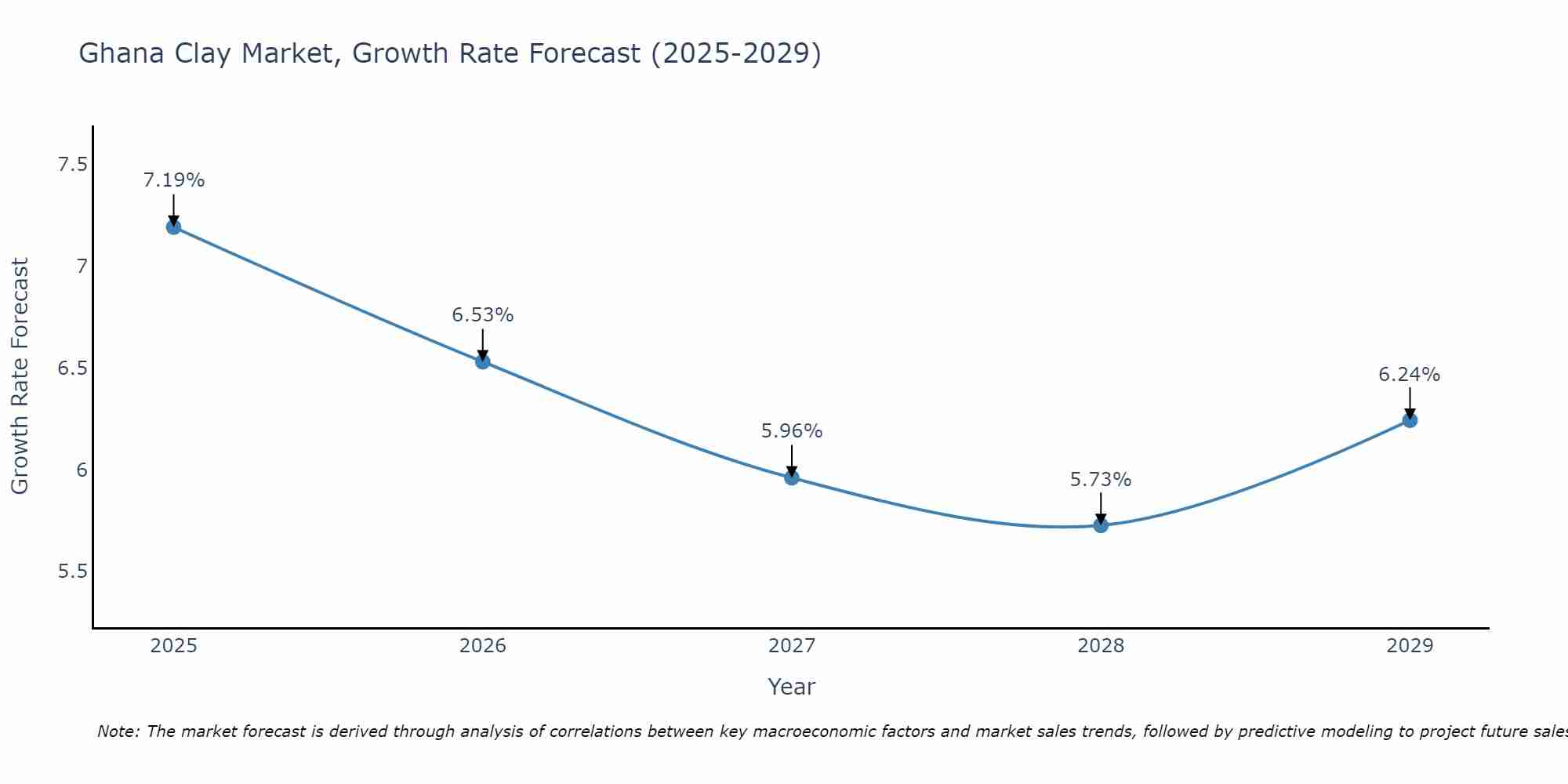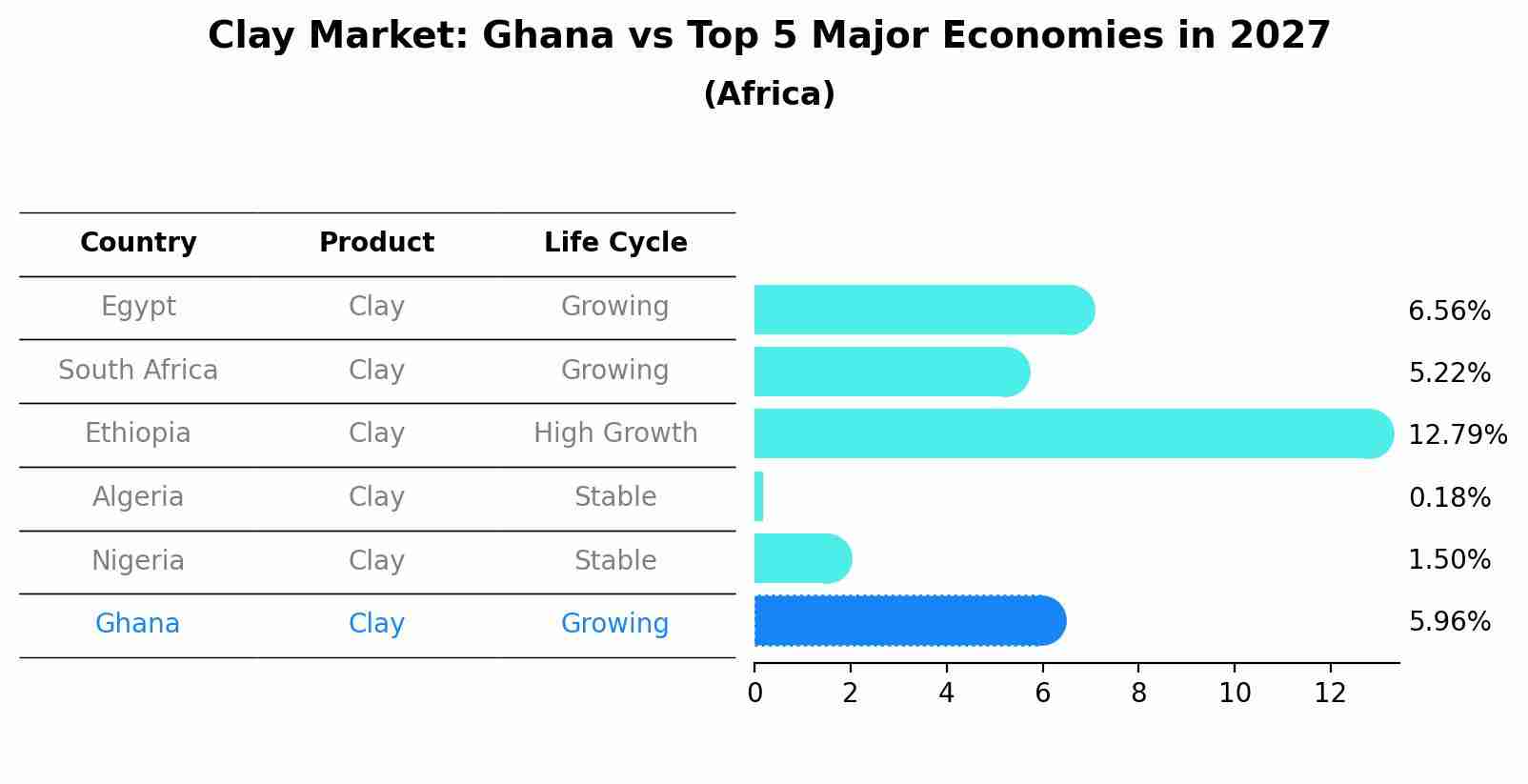Ghana Clay Market (2025-2031) Outlook | Trends, Growth, Forecast, Value, Share, Companies, Industry, Size, Analysis & Revenue
| Product Code: ETC319016 | Publication Date: Aug 2022 | Updated Date: Aug 2025 | Product Type: Market Research Report | |
| Publisher: 6Wresearch | Author: Shubham Padhi | No. of Pages: 75 | No. of Figures: 35 | No. of Tables: 20 |
Ghana Clay Market Size Growth Rate
The Ghana Clay Market is projected to witness mixed growth rate patterns during 2025 to 2029. Although the growth rate starts strong at 7.19% in 2025, it steadily loses momentum, ending at 6.24% by 2029.

Clay Market: Ghana vs Top 5 Major Economies in 2027 (Africa)
The Clay market in Ghana is projected to grow at a growing growth rate of 5.96% by 2027, highlighting the country's increasing focus on advanced technologies within the Africa region, where Egypt holds the dominant position, followed closely by South Africa, Ethiopia, Algeria and Nigeria, shaping overall regional demand.

Ghana Clay Market Overview
The Ghana Clay Market is driven by factors such as construction activities, pottery manufacturing, and ceramics production. Clay, a natural sedimentary material composed of hydrated aluminum silicates, is used in various applications such as brickmaking, tile manufacturing, pottery crafting, and ceramics production in Ghana. With abundant clay deposits and diverse applications, the clay market in Ghana supports infrastructure development, artisanal industries, and manufacturing sectors, contributing to economic growth and employment opportunities.
Drivers of the market
The Ghana clay market is driven by its applications in construction, ceramics, and pottery. Factors such as infrastructure development, urbanization, and cultural heritage preservation influence the demand for clay products in the country.
Challenges of the market
In the clay market in Ghana, challenges arise from limited access to high-quality clay deposits and extraction technologies. Additionally, competition from alternative building materials and environmental regulations impact market sustainability and land use practices in clay mining operations.
Government Policy of the market
Government interventions in the clay market may aim to promote sustainable mining practices, value addition, and industrial development. Policies might include regulations and standards for clay extraction, processing, and utilization to ensure environmental sustainability, resource conservation, and community engagement. Additionally, the government may support investments in clay processing facilities, product development, and market promotion to enhance local value addition and market competitiveness. Capacity-building programs for clay miners, processors, and end-users on sustainable mining practices, product quality standards, and market access may also be promoted to enhance industry sustainability and socio-economic development.
Key Highlights of the Report:
- Ghana Clay Market Outlook
- Market Size of Ghana Clay Market, 2024
- Forecast of Ghana Clay Market, 2031
- Historical Data and Forecast of Ghana Clay Revenues & Volume for the Period 2021-2031
- Ghana Clay Market Trend Evolution
- Ghana Clay Market Drivers and Challenges
- Ghana Clay Price Trends
- Ghana Clay Porter's Five Forces
- Ghana Clay Industry Life Cycle
- Historical Data and Forecast of Ghana Clay Market Revenues & Volume By Application for the Period 2021-2031
- Historical Data and Forecast of Ghana Clay Market Revenues & Volume By Tableware for the Period 2021-2031
- Historical Data and Forecast of Ghana Clay Market Revenues & Volume By Sanitary ware for the Period 2021-2031
- Historical Data and Forecast of Ghana Clay Market Revenues & Volume By Medical applications for the Period 2021-2031
- Historical Data and Forecast of Ghana Clay Market Revenues & Volume By End Use for the Period 2021-2031
- Historical Data and Forecast of Ghana Clay Market Revenues & Volume By Ceramic and for the Period 2021-2031
- Historical Data and Forecast of Ghana Clay Market Revenues & Volume By Non-ceramic for the Period 2021-2031
- Ghana Clay Import Export Trade Statistics
- Market Opportunity Assessment By Application
- Market Opportunity Assessment By End Use
- Ghana Clay Top Companies Market Share
- Ghana Clay Competitive Benchmarking By Technical and Operational Parameters
- Ghana Clay Company Profiles
- Ghana Clay Key Strategic Recommendations
Frequently Asked Questions About the Market Study (FAQs):
1 Executive Summary |
2 Introduction |
2.1 Key Highlights of the Report |
2.2 Report Description |
2.3 Market Scope & Segmentation |
2.4 Research Methodology |
2.5 Assumptions |
3 Ghana Clay Market Overview |
3.1 Ghana Country Macro Economic Indicators |
3.2 Ghana Clay Market Revenues & Volume, 2021 & 2031F |
3.3 Ghana Clay Market - Industry Life Cycle |
3.4 Ghana Clay Market - Porter's Five Forces |
3.5 Ghana Clay Market Revenues & Volume Share, By Application, 2021 & 2031F |
3.6 Ghana Clay Market Revenues & Volume Share, By End Use, 2021 & 2031F |
4 Ghana Clay Market Dynamics |
4.1 Impact Analysis |
4.2 Market Drivers |
4.2.1 Increasing demand for eco-friendly and sustainable construction materials |
4.2.2 Growth in the construction industry in Ghana |
4.2.3 Rising government investments in infrastructure development |
4.3 Market Restraints |
4.3.1 Fluctuations in raw material prices |
4.3.2 Competition from alternative construction materials |
4.3.3 Regulatory challenges related to mining and environmental impact |
5 Ghana Clay Market Trends |
6 Ghana Clay Market, By Types |
6.1 Ghana Clay Market, By Application |
6.1.1 Overview and Analysis |
6.1.2 Ghana Clay Market Revenues & Volume, By Application, 2021-2031F |
6.1.3 Ghana Clay Market Revenues & Volume, By Tableware, 2021-2031F |
6.1.4 Ghana Clay Market Revenues & Volume, By Sanitary ware, 2021-2031F |
6.1.5 Ghana Clay Market Revenues & Volume, By Medical applications, 2021-2031F |
6.2 Ghana Clay Market, By End Use |
6.2.1 Overview and Analysis |
6.2.2 Ghana Clay Market Revenues & Volume, By Ceramic and, 2021-2031F |
6.2.3 Ghana Clay Market Revenues & Volume, By Non-ceramic, 2021-2031F |
7 Ghana Clay Market Import-Export Trade Statistics |
7.1 Ghana Clay Market Export to Major Countries |
7.2 Ghana Clay Market Imports from Major Countries |
8 Ghana Clay Market Key Performance Indicators |
8.1 Percentage of construction projects using clay materials |
8.2 Average selling price of clay products |
8.3 Number of new infrastructure projects announced |
8.4 Percentage of clay deposits with viable reserves |
8.5 Adoption rate of eco-friendly construction practices using clay |
9 Ghana Clay Market - Opportunity Assessment |
9.1 Ghana Clay Market Opportunity Assessment, By Application, 2021 & 2031F |
9.2 Ghana Clay Market Opportunity Assessment, By End Use, 2021 & 2031F |
10 Ghana Clay Market - Competitive Landscape |
10.1 Ghana Clay Market Revenue Share, By Companies, 2024 |
10.2 Ghana Clay Market Competitive Benchmarking, By Operating and Technical Parameters |
11 Company Profiles |
12 Recommendations |
13 Disclaimer |
- Single User License$ 1,995
- Department License$ 2,400
- Site License$ 3,120
- Global License$ 3,795
Search
Related Reports
- ASEAN Bearings Market (2025-2031) | Strategy, Consumer Insights, Analysis, Investment Trends, Opportunities, Growth, Size, Share, Industry, Revenue, Segments, Value, Segmentation, Supply, Forecast, Restraints, Outlook, Competition, Drivers, Trends, Demand, Pricing Analysis, Competitive, Strategic Insights, Companies, Challenges
- Europe Flooring Market (2025-2031) | Outlook, Share, Industry, Trends, Forecast, Companies, Revenue, Size, Analysis, Growth & Value
- Saudi Arabia Manlift Market (2025-2031) | Outlook, Size, Growth, Trends, Companies, Industry, Revenue, Value, Share, Forecast & Analysis
- Uganda Excavator, Crane, and Wheel Loaders Market (2025-2031) | Strategy, Consumer Insights, Analysis, Investment Trends, Opportunities, Growth, Size, Share, Industry, Revenue, Segments, Value, Segmentation, Supply, Forecast, Restraints, Outlook, Competition, Drivers, Trends, Demand, Pricing Analysis, Competitive, Strategic Insights, Companies, Challenges
- Rwanda Excavator, Crane, and Wheel Loaders Market (2025-2031) | Strategy, Consumer Insights, Analysis, Investment Trends, Opportunities, Growth, Size, Share, Industry, Revenue, Segments, Value, Segmentation, Supply, Forecast, Restraints, Outlook, Competition, Drivers, Trends, Demand, Pricing Analysis, Competitive, Strategic Insights, Companies, Challenges
- Kenya Excavator, Crane, and Wheel Loaders Market (2025-2031) | Strategy, Consumer Insights, Analysis, Investment Trends, Opportunities, Growth, Size, Share, Industry, Revenue, Segments, Value, Segmentation, Supply, Forecast, Restraints, Outlook, Competition, Drivers, Trends, Demand, Pricing Analysis, Competitive, Strategic Insights, Companies, Challenges
- Angola Excavator, Crane, and Wheel Loaders Market (2025-2031) | Strategy, Consumer Insights, Analysis, Investment Trends, Opportunities, Growth, Size, Share, Industry, Revenue, Segments, Value, Segmentation, Supply, Forecast, Restraints, Outlook, Competition, Drivers, Trends, Demand, Pricing Analysis, Competitive, Strategic Insights, Companies, Challenges
- Israel Intelligent Transport System Market (2025-2031) | Strategy, Consumer Insights, Analysis, Investment Trends, Opportunities, Growth, Size, Share, Industry, Revenue, Segments, Value, Segmentation, Supply, Forecast, Restraints, Outlook, Competition, Drivers, Trends, Demand, Pricing Analysis, Competitive, Strategic Insights, Companies, Challenges
- Uganda Precast and Aggregate Market (2025-2031) | Strategy, Consumer Insights, Analysis, Investment Trends, Opportunities, Growth, Size, Share, Industry, Revenue, Segments, Value, Segmentation, Supply, Forecast, Restraints, Outlook, Competition, Drivers, Trends, Demand, Pricing Analysis, Competitive, Strategic Insights, Companies, Challenges
- Australia IT Asset Disposal Market (2025-2031) | Strategy, Consumer Insights, Analysis, Investment Trends, Opportunities, Growth, Size, Share, Industry, Revenue, Segments, Value, Segmentation, Supply, Forecast, Restraints, Outlook, Competition, Drivers, Trends, Demand, Pricing Analysis, Competitive, Strategic Insights, Companies, Challenges
Industry Events and Analyst Meet
Our Clients
Whitepaper
- Middle East & Africa Commercial Security Market Click here to view more.
- Middle East & Africa Fire Safety Systems & Equipment Market Click here to view more.
- GCC Drone Market Click here to view more.
- Middle East Lighting Fixture Market Click here to view more.
- GCC Physical & Perimeter Security Market Click here to view more.
6WResearch In News
- Doha a strategic location for EV manufacturing hub: IPA Qatar
- Demand for luxury TVs surging in the GCC, says Samsung
- Empowering Growth: The Thriving Journey of Bangladesh’s Cable Industry
- Demand for luxury TVs surging in the GCC, says Samsung
- Video call with a traditional healer? Once unthinkable, it’s now common in South Africa
- Intelligent Buildings To Smooth GCC’s Path To Net Zero













